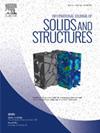Micromechanical investigation of the asymptotic behaviour of granular materials
IF 3.4
3区 工程技术
Q1 MECHANICS
International Journal of Solids and Structures
Pub Date : 2025-04-30
DOI:10.1016/j.ijsolstr.2025.113423
引用次数: 0
Abstract
Laboratory experiments have shown that the proportional shearing of granular materials along arbitrary strain path directions will lead to stress states that converge asymptotically to proportional stress paths with constant stress ratios. The macro- and microscopic characteristics of this asymptotic behaviour, as well as the existence of asymptotic states exhibiting a constant stress ratio and a steady strain-rate direction, have been studied using the discrete element method (DEM). Proportional shearing along a wide range of strain-rate directions and from various initial stress/density states has been conducted. The simulation results suggest that general contractive asymptotic states (except for isotropic states) do exist but may be practically unattainable. Dilative strain path simulations, on the other hand, result in continuously changing stress ratios until static liquefaction occurs, indicating the absence of dilative asymptotic states. Despite this difference, a unique relationship between the stress increments and the current stress ratio gradually emerges from all strain path simulations, regardless of strain path direction and initial stress/density conditions. At the particle scale, the granular assembly sheared along proportional strain paths exhibits a constant partition ratio between strong and weak contacts. Although general proportional strain paths are associated with changing geometric and mechanical anisotropies, the rates of change in these anisotropies for contractive strain paths are synchronised to maintain a constant ratio of their contributions to the mobilised shear strength of the material, with a higher proportion being contributed by geometric anisotropy for more dilative strain paths.
颗粒材料渐近行为的微观力学研究
室内实验表明,颗粒材料沿任意应变路径方向的比例剪切会导致应力状态渐近收敛于恒定应力比的比例应力路径。用离散元法研究了这种渐近行为的宏观和微观特征,以及具有恒定应力比和稳定应变率方向的渐近状态的存在性。在较宽的应变速率方向和不同的初始应力/密度状态下进行了比例剪切。模拟结果表明,一般收缩渐近状态(各向同性状态除外)确实存在,但实际上可能无法实现。另一方面,膨胀应变路径模拟导致应力比不断变化,直到静态液化发生,表明不存在膨胀渐近状态。尽管存在这种差异,但无论应变路径方向和初始应力/密度条件如何,应力增量与当前应力比之间的独特关系逐渐从所有应变路径模拟中显现出来。在颗粒尺度上,沿比例应变路径剪切的颗粒组合在强接触和弱接触之间呈现恒定的分配比。虽然一般的比例应变路径与几何和力学各向异性的变化有关,但收缩应变路径的各向异性变化率是同步的,以保持它们对材料的动员抗剪强度的贡献的恒定比例,而更多的膨胀应变路径的几何各向异性贡献的比例更高。
本文章由计算机程序翻译,如有差异,请以英文原文为准。
求助全文
约1分钟内获得全文
求助全文
来源期刊
CiteScore
6.70
自引率
8.30%
发文量
405
审稿时长
70 days
期刊介绍:
The International Journal of Solids and Structures has as its objective the publication and dissemination of original research in Mechanics of Solids and Structures as a field of Applied Science and Engineering. It fosters thus the exchange of ideas among workers in different parts of the world and also among workers who emphasize different aspects of the foundations and applications of the field.
Standing as it does at the cross-roads of Materials Science, Life Sciences, Mathematics, Physics and Engineering Design, the Mechanics of Solids and Structures is experiencing considerable growth as a result of recent technological advances. The Journal, by providing an international medium of communication, is encouraging this growth and is encompassing all aspects of the field from the more classical problems of structural analysis to mechanics of solids continually interacting with other media and including fracture, flow, wave propagation, heat transfer, thermal effects in solids, optimum design methods, model analysis, structural topology and numerical techniques. Interest extends to both inorganic and organic solids and structures.

 求助内容:
求助内容: 应助结果提醒方式:
应助结果提醒方式:


